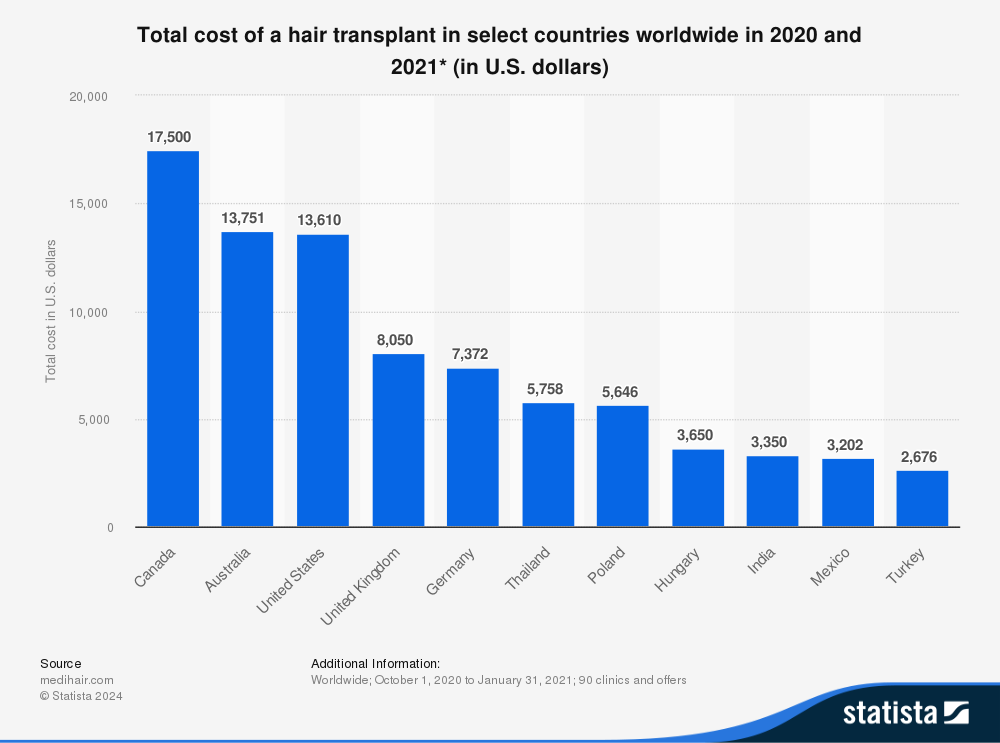
Hair Transplant in Turkey: What are the Risks?
To address their hair loss concerns, many individuals are opting for hair surgeries. Planning such a procedure can represent a significant investment for most patients.
Hair transplants in Turkey have steadily become a highly sought-after option for those wishing to restore fuller hair. The growing popularity of this option is due to its attractive costs combined with the high quality of services provided in this field.
As a result, Turkey has emerged as a top destination for individuals seeking hair transplants, thanks to the competitive prices and exceptional service quality available.
- Key Considerations When Selecting Your Clinic
- What Are the Real Costs of Hair Transplants in Turkey?
- Why Low-Cost Hair Transplant Clinics in Turkey Pose a Serious Risk?
- Assessing the Quality of Turkish Hair Transplant Clinics Compared to European Standards
- Technique Matters: Ensuring Quality in Hair Transplant Surgery
- FAQ
Key Considerations When Selecting Your Clinic
Before beginning the process for your hair transplant, it’s essential to verify these factors to select the clinic best suited to your needs.
Patient Care: 3 Key Rules
From the initial consultation, a consultant will provide you with all necessary information before, during, and after your hair transplant:
- 1. Mandatory Consultation: Following an initial hair analysis, the clinic will conduct a preoperative examination. The practitioner will assess your hair loss and determine the appropriate transplant technique.
- 2. Hygiene Standards: During the procedure, ensure that the operation takes place in a sterilised environment. The team handling your surgery will use the necessary protective measures to minimise infection risk.
- 3. Postoperative Follow-Up: A reputable clinic will guide you in the days following your procedure with a strict healing protocol.
The Reputation of the Clinic
To choose the best clinic, here are some essential criteria to consider:
- Surgeon’s Expertise: Review the surgeon’s experience and qualifications, often available on the clinic’s website.
- Clinic Quality: Available services should be internationally certified.
- Transplant Techniques: The FUE technique for graft extraction and the DHI method for insertion are the most effective methods for treating baldness permanently.
- Personalised Treatment: Patients are only charged for the exact number of grafts needed—no more, no less.
- Price: Pricing should be within the average range for hair transplants in Turkey, typically around four times cheaper than in the UK, with equivalent quality.
What Are the Real Costs of Hair Transplants in Turkey?

In 2023, Turkey welcomed more than 1.5 million patients, becoming the market leader. Between 2020 and 2021, Statista conducted a study on the total cost of a hair transplant.
The average cost of hair transplants. Turkey offered the most attractive rates, with an average price of $2,676 (or £2,086) compared to $8,050 (£6,253) in the UK.
How are these prices so affordable? The Turkish government promotes medical tourism by lowering taxes for clinics. The cost of living is also lower in Turkey than in the UK, which is reflected in the lower prices of hair transplants.
This favourable environment allows medical teams to dedicate more resources to research and the development of new procedures.
Why Low-Cost Hair Transplant Clinics in Turkey Pose a Serious Risk?
While Turkey is a global leader in affordable, high-quality hair transplant surgery, patients should exercise caution with clinics offering prices below the industry standard £2,500. These low-cost options often lack the necessary certifications, employ unqualified technicians, and fail to adhere to essential hygiene protocols, greatly increasing the risk of infections, scarring, and substandard results.
Reputable clinics maintain the highest medical standards, employ licensed specialists, and often include aftercare and advanced techniques in their packages. For safe, effective results, consider only official Turkish clinics with transparent credentials to protect both your health and your investment.
Assessing the Quality of Turkish Hair Transplant Clinics Compared to European Standards
Turkish hair transplant clinics have emerged as top global destinations, often praised for their quality and affordability compared to European counterparts. Clinics in Turkey, especially those in Istanbul, attract international patients by combining high medical standards, advanced techniques and cost-effective packages.
Many of these clinics hold accreditations from global health authorities, ensuring adherence to rigorous hygiene and safety protocols. Highly skilled surgeons with international training and experience are common in well-established Turkish clinics, with patient satisfaction levels comparable to those of reputable European facilities.
However, choosing accredited clinics with transparent pricing and certified professionals is essential, as the quality can vary significantly in clinics offering very low-cost procedures.
Technique Matters: Ensuring Quality in Hair Transplant Surgery
Poorly executed procedures, often due to inadequate technique or overuse of the donor area, can lead to significant follicle loss and permanently weaken the donor site.
Older methods, like FUT or robotic-assisted hair transplantation, may result in less natural outcomes than modern, precision techniques such as FUE or DHI. Risks associated with hair transplants exist across the board, whether in the UK or abroad.
Therefore, it’s essential to take the time to select a reputable hair loss clinic that specialises in the latest methods and offers skilled, experienced surgeons for optimal results. For a detailed overview of the procedures, recovery expectations, and what to look for when choosing a clinic abroad, read our hair transplant Turkey guide. It explains every step of the process and helps you make an informed, confident decision about your treatment.
FAQ
What are the potential complications specific to certain hair transplant techniques, such as FUE or DHI?
Different hair transplant techniques can present specific risks. For instance, FUE might lead to over-harvesting of donor areas if not managed well, potentially causing thinning in these areas. DHI, while minimally invasive, requires precise skill; otherwise, it can lead to follicle misplacement.
How can patients minimise the risks of scarring after a hair transplant?
Postoperative care, including proper wound care, avoiding sun exposure, and adhering to any recommended treatments, is crucial in reducing scarring. Some clinics may offer follow-up treatments to support healing and minimise visible scarring.
What should patients expect during the recovery process in terms of discomfort or visible signs?
Patients may experience redness, swelling, and mild pain around the transplant area, typically subsiding within a few days to weeks. Full hair growth and the natural look of the transplant can take several months to become fully visible.
Are there age or health restrictions for undergoing a hair transplant?
While there is no specific age limit, hair transplants are typically not recommended for very young patients due to unpredictable hair loss patterns. Patients with certain health conditions, such as uncontrolled diabetes or clotting disorders, may also face higher risks and should consult their doctors before considering surgery.
What aftercare is provided by reputable clinics following a hair transplant?
Reputable clinics usually provide detailed aftercare guidance, including medications to prevent infection, guidelines for washing the scalp, and check-ups to monitor healing. Many also offer support for issues such as shock hair loss (temporary hair shedding post-surgery) and scalp itching.
Is it common to experience “shock loss,” and how can it be managed?
Shock loss, or temporary shedding of transplanted or surrounding hair post-procedure, is common and usually resolves within a few months. Proper aftercare and treatments like PRP (Platelet-Rich Plasma) may support faster recovery.


